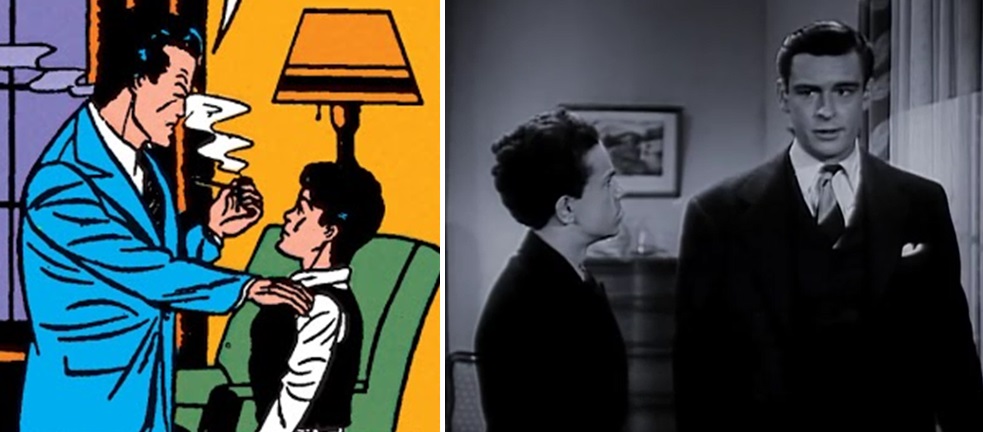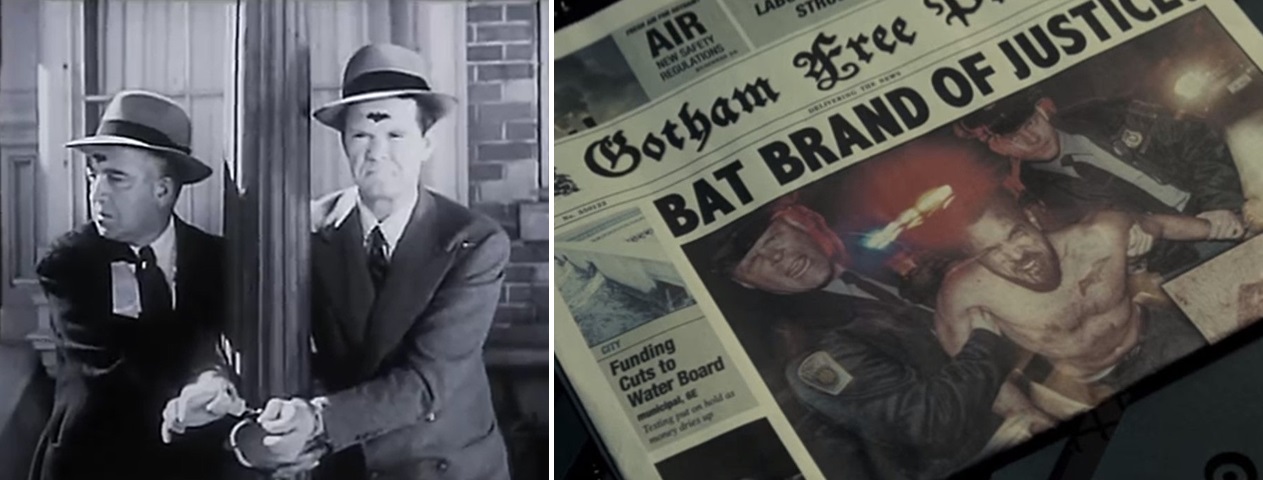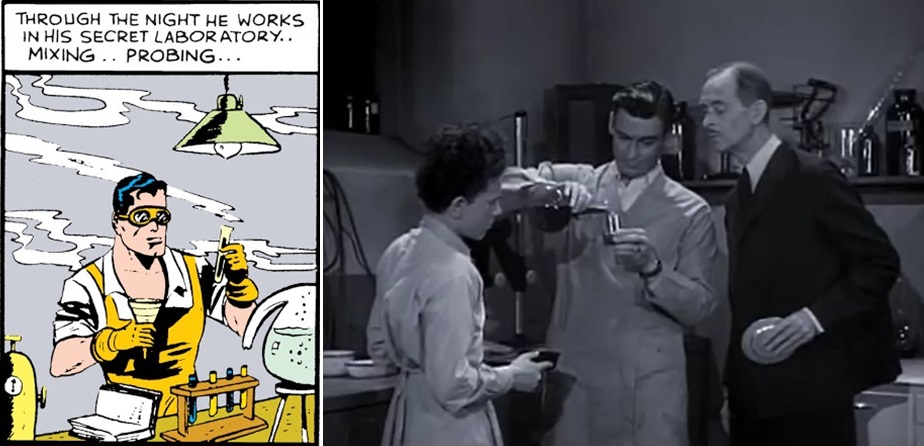INTRODUCTION
We’re ever conscious of landmark dates here at Batman-Online, and 2018 marks a special one in the Caped Crusader’s cinematic history. It’s the 75th anniversary of Batman’s first ever big screen outing: the 1943 black & white film serial directed by Lambert Hillyer and produced by Columbia Pictures.

On the surface there mightn’t appear too much to say about this 15-episode series. The comics had only been in print for four years when the serial went into production and the mythology was still in its infancy. But even so, there are some notable things to comment on. We can evaluate how accurately the earliest screen versions of Batman and Robin correspond with their Golden Age counterparts. And we can highlight the various ways in which the film serial influenced the comics and later adaptations that followed in its wake.
So without further preamble, let's get started.
The first location we see in the serial’s opening chapter is stately Wayne Manor. The narrator tells us it is located “High atop one of the hills that ring the teeming metropolis of Gotham City.” This description may seem redundant to modern viewers, but it’s worth remembering that the earliest Golden Age Batman stories did not take place in Gotham. Instead Bruce Wayne originally operated out of an apartment in New York City. The name Gotham City didn’t appear until ‘The Case of the Joker’s Crime Circus’ (Batman Vol 1 #4, December 1940).

Although the name Gotham City is used throughout the serial, Bruce Wayne’s postal address is at one point shown to be located in Los Angeles, California. This discrepancy is never explained.

From Wayne Manor, we descend to the mysterious Bat's Cave where flying rodents are shown fluttering above the solitary figure of the Caped Crusader. The Batcave is referred to throughout this serial as ‘The Bat’s Cave’, which is also the title of the second chapter. The Batcave as we know it today did not exist in the comics at the time of this serial’s production. Instead early stories had featured a secret tunnel linking Wayne Manor to a nearby barn/hangar where some of Batman’s equipment was stored. Batman also had a crime lab in a cellar beneath his home, but it was not a cave. The cave in the film serial is essentially a combination of the crime lab, the secret tunnel and the barn/hangar. A similar base was later incorporated into the comics, and thus the classic Batcave was born.

The cave in this serial was likely inspired by the hideout of Don Diego de la Vega in the 1920 film version of The Mark of Zorro starring Douglas Fairbanks.
The secret entrance to the cave is hidden inside a grandfather clock in Wayne Manor. This is another detail that originated in the film serial and was subsequently worked into the comics.

Lewis Wilson faced the challenge of becoming the first actor to portray Batman and his alter ego Bruce Wayne. He was only around 23 at the time and remains the youngest actor to play the adult version of the character in live action. In keeping with the comics of the era, Wilson's Batman is frequently referred to as 'the Batman'.

Batman’s costume is a faithful albeit cheap recreation of the Golden Age/Earth-Two batsuit. He wears a utility belt, but is never shown to extract any gadgets from its containers. The only gadgets Batman and Robin are shown using in this serial are their pocket radios and grappling ropes. The Golden Age Batman and Robin were equipped with similar ropes and also used miniature radios to maintain contact during missions.

The serial portrays Batman as an agent of the US government who receives his orders from Washington DC. The Golden Age Batman was a deputised agent of the law and served a similarly active role in battling foreign spies during World War II.
The first actor to portray Robin the Boy Wonder was Douglas Croft. His costume is faithful to the source material..

There is no Batmobile in this serial. Instead Batman and Robin drive around in a Cadillac convertible. This reflects the earliest Golden Age stories, in which Batman drove regular nondescript automobiles.

When not in costume, Batman and Robin are better known as wealthy playboy Bruce Wayne and his young ward Dick Grayson.

Unlike the Golden Age Batman and Robin, who were trained in a variety of combat techniques such as boxing and jiu-jitsu, the versions presented in this serial display no discernible martial arts skill whatsoever. The fight scenes chiefly consist of them pouncing on the villains and repeatedly socking them with clumsy haymakers. Robin in particular gets the stuffing beaten out of him in practically every fight scene. And Batman doesn’t fare much better.

Batman and Robin make numerous dramatic entrances by leaping and swinging through windows.

Wilson’s Batman is shown to jump onto moving vehicles with reckless abandon. The Golden Age Batman frequently executed similar feats of derring-do.

Batman and Robin also display acrobatic skills comparable to those of their comic book incarnations.

At one point Batman causes a van to crash over the edge of a cliff with a number of criminals still inside. The scene ends with Batman saying he’s going to try and help the men in the wreckage, but in the following scene the villain informs his underlings that the men did not survive. Although this serial was produced after the Caped Crusader had adopted his no kill rule in the comics, that didn’t stop the Golden Age Batman from using lethal force on rare instances. The scene in the film where he causes the van to go over a cliff resembles the finale of ‘Peril in Paris’ (Detective Comics Vol 1 #34, December 1939) where he causes Duc D'Orterre’s car to plummet over a precipice in an almost identical manner. In both stories, Batman himself manages to leap to safety before the careening vehicle carries its passenger(s) to their doom.

Batman is responsible for the deaths of at least two other criminals later in the serial. One sequence sees the Caped Crusader held prisoner in a house containing a store of dynamite. The villains light the fuse on the explosives and try to flee, but Batman grabs the last of them, beats him unconscious and leaves him to die while he and Robin escape through a trapdoor. Towards the end of the serial Batman is knocked unconscious and placed in a coffin for delivery to the main villain. But he awakens en route and switches places with his captor. The coffin containing the unfortunate goon is then dropped into a pit of crocodiles by the villain and the occupant dies in Batman’s place. The point in mentioning these examples is to emphasise that this Batman’s attitude to killing is aligned with the more flexible principles of the Golden Age incarnation.
When Batman and Robin hand criminals over to the police, they stamp them on the forehead with a bat symbol. This may have been the inspiration for the bat-brand used by the Ben Affleck Batman in Zack Snyder’s Batman v Superman: Dawn of Justice (2016).

The Dynamic Duo leave criminals trussed up on the steps of police headquarters.

Batman also sends letters to the police signed with a bat symbol.

Wilson’s Batman is portrayed as a skilled chemist. There are numerous scenes depicting him and Robin at work in their crime lab.

At one point Dick disguises himself as a newsboy. He also did this during his debut story in the comics: ‘Robin the Boy Wonder’ (Detective Comics Vol 1 #38, April 1940).

Batman creator Bob Kane also makes a cameo as a newsboy in the first chapter. Newsboys were commonly used to relate important plot points in the Golden Age comics.

The traditional bat-signal atop police headquarters does not appear in this serial. However Robin does shine a miniature bat-signal through a window into a criminal’s hideout in one scene.

The main love interest in this serial is Linda Page, played by Shirley Patterson. Linda was one of Bruce’s earliest girlfriends in the comics following the cancellation of his engagement to Julie Madison. She first appeared in ‘Crime Does Not Pay’ (Batman Vol 1 #5, March 1941).

Bruce antagonises Linda by pretending to be an idle layabout playboy. This is consistent with how Bruce’s playboy persona was depicted in the Golden Age comics. Back then it was less about extrovert displays of obnoxious wealth and more about comical gestures of lethargic disinterest.

Linda is captured and held prisoner by the villains during the latter part of the serial. She was regularly taken prisoner by criminals in the comics, with the earliest example being during her debut story in the aforementioned Batman Vol 1 #5.

The villains take Linda prisoner in the serial after observing a connection between her and Batman. In ‘The Trouble Trap’ (Batman Vol 1 #7, October 1941) a gang of criminals take Linda prisoner after an evil mystic named Granda makes a similar observation. Batman eventually rescues Linda from her captors in both the comic and the serial.
The character of Granda was portrayed as an evil fortune teller. There’s a similar character in the film serial named Swami Dhar who is also involved in an attempt to capture Linda. Both of these characters exemplify how people of Asian extraction were commonly portrayed as evil in the pulp fiction of the era.

Another major comic book character to appear in this serial is Alfred. Alfred Beagle debuted in the comics in ‘Here Comes Alfred’ (Batman Vol 1 #16, April 1943) and was originally portrayed as a clean-shaven, overweight butler with a passion for detective literature. The appearance of actor William Austin was clearly at odds with the version in the comics at the time. Instead of being short and fat, he was tall and slim and sported a neatly trimmed moustache. Austin’s likeness was later incorporated into the comics in the story ‘Accidentally on Purpose’ (Detective Comics Vol 1 #83, January 1944), where it was explained that the character had spent time at a health spa shedding his excess weight. Austin’s likeness continues to serve as the basis for Alfred’s appearance in the modern comics. So this is another example of the long-lasting impact the film serial had on the source material.

Austin’s Alfred shares the comic book version’s love of detective fiction.

He is also portrayed as a master of disguise and Bruce calls upon his makeup skills several times throughout the serial. The Golden Age Alfred had previously been an actor and was also skilled at disguising himself with makeup.
Bruce is also shown to be adept at the art of disguise. He adopts the persona of a lowlife criminal in order to infiltrate underworld turf and gather information on his enemies. The Golden Age Batman often used similar disguises in the comics.

The main villain in this serial is a Japanese Axis agent and cult leader named Dr. Tito Daka/Prince Daka, played by 2-time Academy Award nominee J. Carrol Naish. Although Daka is not based on any one specific comic book villain, he is fairly typical of the ‘Japanazi’ stereotypes that were common in the wartime comics. The crude racial stereotyping of the Japanese throughout this serial is also unfortunately typical of the Golden Age era.
The image of Daka sitting in front of the statue in his hideout recalls the leader of the Green Dragon Tong in ‘The Horde of the Green Dragon’ (Detective Comics Vol 1 #39, May 1940). Here we have yet another example of an evil Asian stereotype. The Green Dragon Tong leader orchestrates his criminal cult out of Chinatown, whereas Daka’s operation is based in Little Tokyo.

Daka’s use of mind control techniques to transform American scientists into his zombie slaves may have been influenced by the titular villain in ‘The Strange Case of the Diabolical Puppet Master’ (Batman Vol 1 #3, September 1940). The Puppet Master, like Daka, uses hypnosis to steal the research of American scientists. But while the Puppet Master plans to sell his stolen inventions to warring nations, Daka reserves his purloined technology for the Japanese war effort.

Both villains attempt to acquire an experimental new gun. The Puppet Master attempts to steal the Voss Rifle, while Daka is after the Radium Gun. Both stories include a scene where the villain’s henchmen attempt to attack a train, only to be foiled by Batman and Robin. And both stories depict the villain attempting to take control of Batman’s mind.
The Radium Gun might have been inspired by ‘The Strange Case of Professor Radium’ (Batman Vol 1 #8, December 1941), in which the eponymous villain had the ability to shoot lethal radium rays from his hands.

One of this serial's many cliffhangers involves Daka trapping Batman in a cell with converging spiked walls. This sequence is a precursor to numerous similar set pieces in the comics, as well as a scene in the Batman (1966-68) television episode ‘The Purr-fect Crime’ (season 1 episode 19).

While Daka was created especially for the film serial, he did eventually make the transition into the comics during a storyline that ran in All-Star Squadron Vol 1 #42-43 (February-March 1985).

Although this story was published during the Bronze Age, it is set during the Golden Age – specifically 1942, one year before the events of the film serial – and is part of the Earth-Two canon. The portrayal of Daka in the comics is consistent with how he is depicted in the film serial. In both stories he is the leader of a criminal cult and is on a mission to acquire new technology on behalf of the Axis powers. His pursuit of the Gravity Rod in the comics reflects his pursuit of the Radium Gun in the film serial.
I’ll end this analysis with an interesting nugget from writer Roy Thomas, taken from the letters page in All-Star Squadron Vol 1 #47 (July 1985). When one fan praised the character of Daka and asked if he would return in future stories, Thomas gave the following response.

Batman adaptations are generally regarded as taking place in universes separate from those of the comics. But here Thomas suggests the events of the 1943 Batman serial will occur after the events of All-Star Squadron Vol 1 #42-43. He assures another reader that Daka has vowed to return in search of more weapons technology. And while this never happened in the comics, the film serial does show Daka returning in 1943 in an effort to procure the Radium Gun. Are we then to take it that Lewis Wilson’s Batman is in fact the Golden Age Batman of Earth-Two? Or is this just a writer having fun with his readers?
Either way, that brings me to the end of this analysis.
comments powered by Disqus












by Silver Nemesis
by Silver Nemesis
by Silver Nemesis
by The Joker
by The Joker
by The Joker
by The Joker
by The Dark Knight
by Silver Nemesis
by The Dark Knight